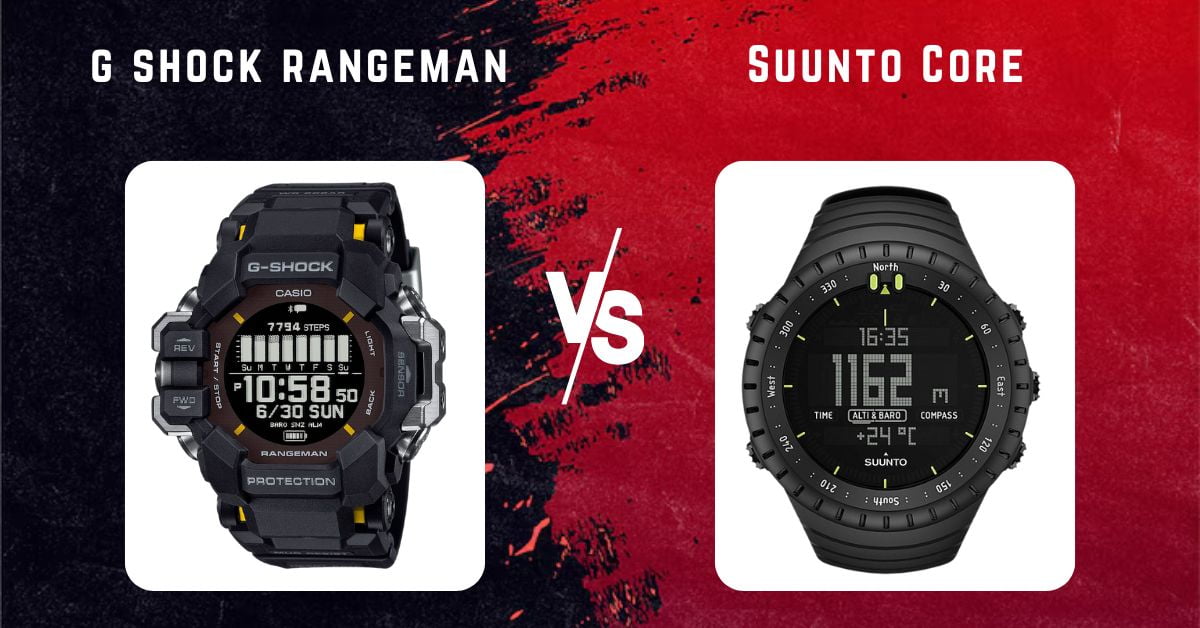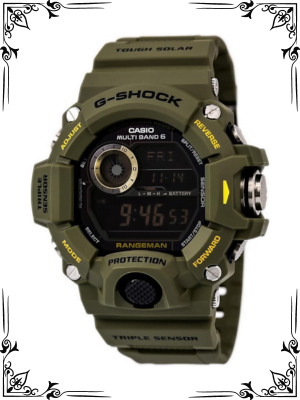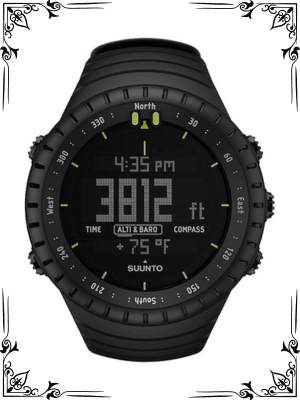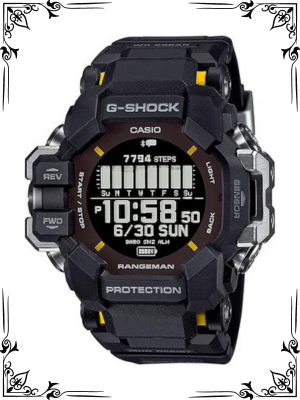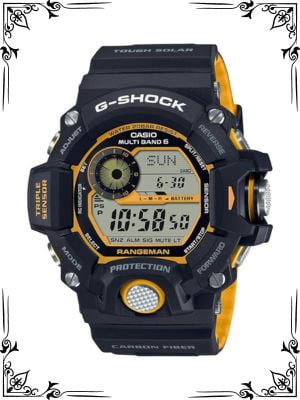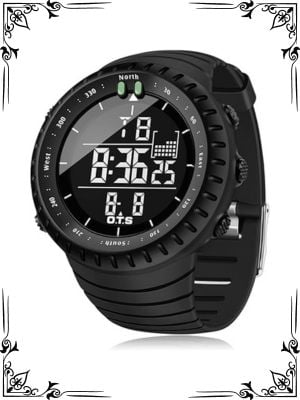The G-Shock Rangeman prioritizes legendary durability and navigation features, perfect for extreme environments. The Suunto Core offers a good balance of basic fitness tracking, navigation tools, and excellent battery life, ideal for outdoor enthusiasts seeking a comfortable and reliable companion.
Introduction
You crave adventure. Hiking, camping, and pushing your limits in the wilderness fuel your soul. But venturing into the unknown requires a reliable companion on your wrist – a watch built to conquer the elements and provide the tools you need to navigate and stay safe.
Two titans rise to the challenge: the Casio G-Shock Rangeman and the Suunto Core. Both boast impressive durability and robust features, but which one reigns supreme for your next outdoor odyssey? Let’s delve deep and uncover the champion that best suits your needs.
A Legacy of Exploration: A Look at History
G-Shock: Casio’s G-Shock line needs no introduction. Since 1983, these timepieces have become synonymous with near-indestructible build quality. The Rangeman, released in 2014, lives up to this legacy, boasting a reputation for withstanding extreme temperatures, shocks, vibrations, and even mud and dust.
Suunto: Founded in 1936, Suunto has a rich history in crafting precision instruments for outdoor activities. The Suunto Core, launched in 2008, embodies this heritage. Built with the needs of adventurers in mind, the Core offers a blend of functionality and durability.
Design and Build Quality: Built to Endure
Looks: The G-Shock Rangeman sports a bold, imposing design that screams durability. Its large buttons and prominent case are a testament to its ability to take a beating. The Suunto Core has a more streamlined and minimalist aesthetic, prioritizing functionality and readability.
Materials: Both watches utilize top-notch materials to ensure they can handle anything you throw at them. The Rangeman features a shock-resistant resin case and a robust mineral glass display. The Suunto Core boasts a lightweight composite case and a scratch-resistant sapphire crystal display, known for its exceptional clarity and durability.
Display: The Rangeman has a smaller (1.2-inch) digital display with basic functionality. It prioritizes clarity and readability in all conditions, even with gloves on. The Suunto Core has a slightly larger (1.3-inch) negative LCD display with better contrast, offering improved readability in various lighting conditions.
Comfort: The Rangeman’s bulkier design, with its larger buttons and prominent case, might feel heavier (89 grams) on some wrists. The Suunto Core’s lighter weight (69 grams) and softer strap material provide superior breathability and a more comfortable fit for extended wear.
Here’s a table summarizing the key build quality and design aspects:
| Feature | G-Shock Rangeman | Suunto Core |
|---|---|---|
| Display Size | 1.2 inches | 1.3 inches |
| Display Resolution | Not specified | Negative LCD |
| Touchscreen | No | No |
| Weight | 89 grams | 69 grams |
| Strap Material | Resin | Silicone or textile |
| Case Material | Shock-resistant Resin | Composite |
Feature Face-Off: Fitness, Navigation, and Beyond
While both watches excel in different areas, understanding their feature sets is crucial for making an informed decision.
Health and Fitness: The G-Shock Rangeman prioritizes navigation features over in-depth health tracking. It offers basic functionalities like step tracking, distance, and calories burned, but that’s where its capabilities end.
The Suunto Core offers basic fitness tracking features like steps, distance, and calories burned. While not as comprehensive as some modern smartwatches, it provides a good starting point for tracking your activity levels.
Some Suunto Core models also boast heart rate monitoring, providing valuable insights into your exertion levels during workouts.
Built-in Sensors: This is where the Rangeman truly shines. It comes equipped with a barometer, altimeter, compass, and thermometer – essential tools for navigating challenging environments.
These sensors can be invaluable for tracking elevation changes, monitoring weather patterns, and maintaining a sense of direction. The Suunto Core also offers a barometer, altimeter, and compass, making it a capable navigation tool.
Fitness Tracking Capabilities:
While the Rangeman offers basic activity tracking, the Suunto Core goes a step further with features like workout summaries, recovery time estimates, and basic training programs. Some models with heart rate monitoring allow for more advanced training analysis based on heart rate zones.
Unique Health Features: Neither watch offers the extensive health monitoring features found in some modern smartwatches.
However, The Suunto Core boasts a recovery time estimation feature that analyzes your training data and suggests an appropriate amount of rest before your next session. This can help prevent overtraining and optimize your workout routine.
Notification Options: Both watches can display notifications from your phone, allowing you to stay connected on the go.
However, the level of interaction with these notifications differs. The Rangeman displays basic information like text message alerts, while the Suunto Core allows limited interaction on some models, like silencing notifications or rejecting calls.
Music and Phone Control: Both watches offer basic music controls like play/pause and volume adjustment. However, their functionalities might differ depending on phone compatibility.
Built-in Apps and Compatibility with Different Phone Ecosystems:
The Rangeman connects to the G-Shock Connected app for basic configuration and limited data tracking. While functional, the app doesn’t offer the same level of detail and customization as some competitors.
The Suunto app offers a wider range of features compared to G-Shock Connected. It allows you to view detailed activity data, access basic training programs and create your own, customize display layouts, and even connect with third-party fitness apps to expand the functionality of your watch.
Both the G-Shock Connected app and Suunto app are compatible with iOS and Android devices.
Here’s a table summarizing the key feature comparison:
| Feature | G-Shock Rangeman | Suunto Core |
|---|---|---|
| Heart Rate Monitor (built-in) | No (Some models with external strap compatibility) | Yes (On some models) |
| GPS | Yes | No |
| Barometer | Yes | Yes |
| Altimeter | Yes | Yes |
| Compass | Yes | Yes |
| Thermometer | Yes | Yes |
| Activity Tracking Modes | Steps, Distance, Calories | Steps, Distance, Calories, Workout summaries (on some models) |
| Advanced Training Features | No | Recovery time estimation, basic training programs (on some models) |
| Stress Tracking | No | No |
| Body Battery Monitoring | No | No |
| Notification interaction | Limited | Limited (on some models) |
Other Features
Battery Life: This is a key differentiator. The Rangeman boasts a staggering 7 months of battery life in watch mode (without Bluetooth) and 30 hours in GPS mode. This makes it ideal for long expeditions where frequent charging isn’t an option.
The Suunto Core offers a respectable 12-month battery life in watch mode and 25 hours with continuous GPS tracking. While impressive, it falls short of the Rangeman’s endurance, especially for extended off-grid adventures.
Water Resistance: Both watches are built to withstand aquatic adventures. They boast a 200-meter water resistance rating, allowing you to swim, shower, and dive worry-free.
Additional Features: The Rangeman offers sunrise/sunset times, world time, and multiple alarms. The Suunto Core boasts a storm alarm that alerts you to sudden changes in barometric pressure, potentially indicating an approaching storm.
Performance and User Experience
Responsiveness: The Rangeman’s button-based interface prioritizes simplicity and functionality. While not the most cutting-edge, it excels in reliability, especially in harsh environments where touchscreens might be less responsive due to wet fingers or gloves.
The Suunto Core’s negative LCD display offers good visibility in various lighting conditions. However, some users might find the button layout less intuitive compared to the Rangeman’s, especially for those accustomed to touchscreens.
App Compatibility: The G-Shock Connected app prioritizes basic functionality like time synchronization and limited data viewing. The Suunto app offers a wider range of data analysis, training tools, and customization options, making it a more comprehensive platform for athletes and fitness enthusiasts.
Battery Life in Action: The Rangeman’s battery life is a clear winner for long expeditions where frequent charging is impractical. However, the Suunto Core’s one-year battery life in watch mode makes it a better choice for everyday wear, striking a balance between functionality and battery life.
Price and Value
G-Shock Rangeman: Prices typically range from $250 to $350. It offers exceptional durability, navigation features, and long battery life, making it ideal for serious adventurers who prioritize off-the-grid exploration and value a no-nonsense, reliable timepiece.
Suunto Core: Prices can vary depending on the model, ranging from $200 to $300. It provides a solid balance of basic fitness tracking, navigation features, a comfortable design, and excellent battery life. It caters to outdoor enthusiasts who value functionality, readability, and a reliable companion for their adventures.
User Feedback: A Real-World Perspective
Both the G-Shock Rangeman and Suunto Core have garnered loyal followings. Here’s a breakdown of what users appreciate about each:
G-Shock Rangeman: Users rave about the legendary toughness, long battery life, and clear, easy-to-read display, especially in challenging environments. The simple button interface is praised for its reliability, even when wet or gloved.
Suunto Core: Users appreciate the comfortable design, good readability of the negative LCD display in various lighting conditions, and user-friendly interface with basic fitness tracking capabilities. The long battery life and built-in barometer are also popular features, especially for outdoor enthusiasts who value practicality.
Here are some additional insights gleaned from user reviews:
Rangeman: Some users report a less user-friendly interface compared to smartwatches with touchscreens. The smaller display might be difficult to read for some, especially with limited customization options.
Suunto Core: While generally praised for comfort, a few users find the silicone strap a bit less breathable compared to some G-Shock Rangeman models with resin straps. The lack of GPS and advanced training features might be a drawback for athletes seeking in-depth performance data.
Common Problems: Navigating the Challenges
G-Shock Rangeman:
Limited fitness tracking features: While offering basic activity tracking, the Rangeman lacks advanced health monitoring functionalities found in some smartwatches.
Smaller display and limited customization options: The display size might be a concern for users who prefer a larger viewing area. Additionally, customization options for the display layout are minimal.
Bulkier design: The Rangeman’s robust build can feel heavy on smaller wrists.
Suunto Core:
No GPS: The absence of GPS might be a dealbreaker for users who rely on precise location tracking during hikes, navigation, or off-road adventures.
Limited app functionality: Compared to some competitors, the Suunto app offers a more basic range of features, especially for advanced training analysis.
Button layout learning curve: While generally user-friendly, some users might find the button layout less intuitive compared to touchscreen interfaces.
Popular Models in the G-Shock Rangeman and Suunto Core Series:
While both the G-Shock Rangeman and Suunto Core offer a variety of functionalities within their series, here are some of the most popular models in each category:
G-Shock Rangeman:
GW-9400 Rangeman: This is the original Rangeman model, released in 2014. It established the core features of the series – durability, navigation sensors (barometer, altimeter, compass, thermometer), and long battery life. It remains a popular choice for its classic design and dependable functionality.
GW-9500 Rangeman Gulfmaster: Building on the GW-9400, the Gulfmaster is designed specifically for maritime environments. It boasts additional features like tide and moon phase tracking, making it ideal for sailors, fishermen, and anyone who spends significant time near water.
GBX-100 Rangeman G-Shock MOVE: This is a newer addition to the Rangeman lineup, incorporating Bluetooth connectivity with the G-Shock MOVE app. While it retains the core navigation features, it allows for some basic data tracking and customization options through the app.
Suunto Core:
Suunto Core (original): Launched in 2008, the original Suunto Core established the core functionalities of the series – basic fitness tracking (steps, distance, calories), navigation features (barometer, altimeter, compass), and a comfortable, lightweight design. It remains a popular choice for its versatility and affordability.
Suunto Core Regular Black: This variant offers all the core features of the original Suunto Core in a sleek black design.
Suunto Core Military: This version caters to military personnel. It boasts additional features like night vision compatibility and a second-time zone display.
Suunto Core Glacier White: This model features a stylish white design while retaining the core functionalities of the Suunto Core.
Suunto Core Alu Black: This variant upgrades the original Suunto Core’s bezel material to aluminum for a more premium look and feel. It might appeal to users who prioritize aesthetics alongside functionality.
Choosing Between Popular Models:
When selecting a specific model within each series, consider your individual needs:
Prioritize extreme durability and long battery life: Opt for the classic G-Shock Rangeman GW-9400 or the Suunto Core (original).
Need features for maritime activities: Choose the GW-9500 Rangeman Gulfmaster.
Desire basic data tracking and app connectivity: Consider the GBX-100 Rangeman G-Shock MOVE or any Suunto Core model with Bluetooth functionality.
Value comfort and basic fitness tracking: The original Suunto Core or any of its variants is a good choice.
Require features for military use: Select the Suunto Core Military.
Prioritize aesthetics: Consider the Suunto Core Glacier White or Suunto Core Alu Black.
Remember, these are just a few of the many models available in each series. It’s always wise to explore the full range of options and specifications before making your final decision.
Choosing Your Champion: The Perfect Match for Your Adventure
The G-Shock Rangeman reigns supreme for:
- Serious adventurers prioritize extreme durability and off-the-grid navigation.
- Users who value a long battery life and a no-nonsense, reliable timepiece that can withstand harsh conditions.
- Those who appreciate a simple, easy-to-read display and a button interface for maximum functionality in any environment.
The Suunto Core is the champion for:
- Outdoor enthusiasts seeking a balance of basic fitness tracking, navigation features, and a comfortable design.
- Users who value a long battery life for everyday wear and occasional outdoor adventures.
- Those who prioritize readability in various lighting conditions and appreciate a user-friendly interface with basic functionalities.
FAQs
Which watch is tougher: G-Shock Rangeman or Suunto Core?
The G-Shock Rangeman takes the crown for sheer toughness. Built with shock resistance in mind, it can handle drops, bumps, and harsh environments more readily than the Suunto Core.
Do I need GPS for outdoor activities?
If precise location tracking and route navigation are crucial for your adventures, then GPS becomes a significant factor. The G-Shock Rangeman lacks built-in GPS, while the Suunto Core (original model) doesn’t have it either. However, some Suunto Core variants offer GPS functionality.
Which watch offers better battery life?
The G-Shock Rangeman reigns supreme in battery life. It boasts a staggering 7 months in watch mode (without Bluetooth) and 30 hours in GPS mode (if available on the model). The Suunto Core offers a respectable 12 months in watch mode, making it a good choice for everyday wear, but falls short of the Rangeman’s endurance for extended expeditions.
Is either watch suitable for fitness tracking?
Both watches offer basic fitness tracking capabilities like steps, distance, and calories burned. However, the Suunto Core edges out slightly with features like workout summaries and recovery time estimation on some models. If serious fitness tracking is your priority, you might want to consider a smartwatch with more comprehensive health monitoring functionalities.
Which watch is more comfortable to wear?
The Suunto Core generally wins in terms of comfort. Its lighter weight and softer strap material make it more breathable for extended wear compared to the G-Shock Rangeman’s bulkier design and resin strap. However, comfort is subjective, so trying on both watches might be helpful in making your decision.
Conclusion
The G-Shock Rangeman and Suunto Core are titans in the rugged watch arena. The Rangeman conquers with its legendary toughness and long battery life, while the Suunto Core excels in readability, comfort, and a good balance of basic functionalities.
Ultimately, the champion depends on your priorities. For the true wilderness warrior, the Rangeman stands strong. For the outdoor enthusiast who values a blend of functionality and comfort, the Suunto Core is a compelling choice.
Consider alternatives like the Casio Pro Trek PRW3500 for solar charging capabilities or the Suunto 9 Baro for advanced training features and built-in GPS. Remember, the perfect watch is the one that best equips you to conquer your next adventure.

